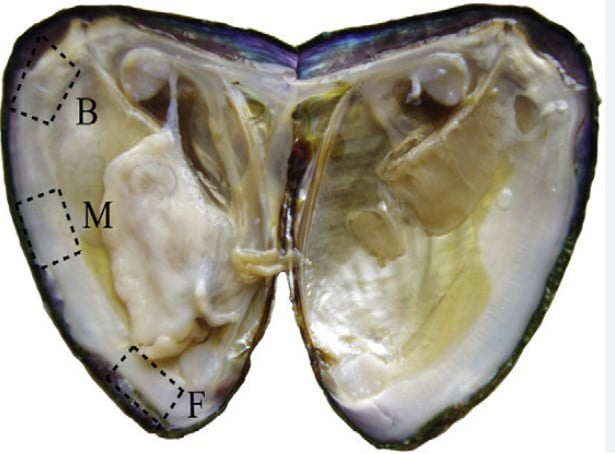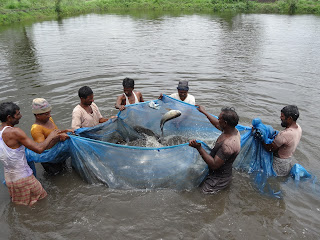Miscellaneous Freshwater Carps Fishes: Except Indian major carps other major carps are commercially important fishes belonging to cyprinidae family. The carp group of fishes are dominant in freshwater resources like rivers, ponds, reservoirs etc. Carps fishes are 85% contribute in freshwater aquaculture. among the carps group some of the miscellaneous fishes also importance. The details of some miscellaneous fishes their characteristic and importance as follows.
Miscellaneous Freshwater Carps Fishes
1. Cirrhinus fulungee (Sykes) 1841.
 |
| Cirrhinus fulungee |
B.3; D.10 (2/8); P.15; V.9; A. 7 (2-5); C.19; L.I. 48; L.tr. 8/9 Barbels 2.
Local names : White Carp
Environment : Benthopelagic, freshwater.
Climate : Tropical.
Dangerous : Harmless.
Characters :
- Length of head is 5.7 and the height of body 5.2 in the total length.
- Snout is slightly over hanging the mouth.
- Mouth is broad and transverse.
- Only one pair very short rostral barbels are present.
- Dorsal fin commences midway between the end of the snout and the posterior end of the base of the anal fin.
- Caudal fin is deeply forked.
- Lateral line is complete.
- Body is brownish along the back, divided by a light bluish band from the silvery abdomen. Dorsal and caudal fins are gray.
Remark : It grows up to 30 cm. in length.
Importance: Fisheries; minor, commercial
2. Labeo boga (Ham ) 1822.
 |
| Labeo boga |
B.3; D.11-13 (2-3/9-10); P.16; V.9; A.7 (2/5); C.19; L. I. 37-39; L. tr. 6 ½ – 7/7; Barbels 2.
Popular names : Burmese fish, jumuna fish.
Local names : Boga
Environment : Benthopelagic,potamodromous, freshwater.
Climate : Tropical.
Dangerous : Harmless.
Characters :
- Length of head ranges from 5.2 to 5.5 and the height of body from 5.5 to 5.7 in the total length.
- Body is moderately elongated and the abdomen is rounded.
- Eyes are situated slightly before the middle of the length of the head.
- Barbels are two, minute maxillary in position.
- Dorsal fin commences in much advance of the ventral fins.
- Caudal fin is deeply forked with both of its equal lobes.
- Lateral line is complete.
- Body is orange with the fins of reddish tinge; sometimes a dark spot is present on the shoulder.
Remarks : It attains a maximum length of 30cm; like other carp, it also spawn in flooded river.
Importance : It renowned as a tasty fish. This species can be culture in ponds and tanks
3. Labeo fimbratus (Bloch) 1769.
 |
| Labeo fimbratus |
B.3; D.19-22 (3-4/15,18); P .17; V.9; A.7(2/5); C.19; L.I. 44-47; L.tr. 9-10/8 Barbels 4.
Popular names : Labeonain
Local names : Labeo
Environment : Benthopelagic, freshwater, Potamodromous.
Climate : Tropical
Dangerous : Harmless.
Characters :
- Length of head ranges from 6.2 to 6.5 and the height of body from 4 to 4.5 in the total length.
- Body profile is moderately elongated and the abdomen is rounded.
- The snout is obtuse, rather swollen and beset with minute pores but it is divide of lateral lobes.
- Two short rostral and two maxillary barbels are present.
- The dorsal fin commences s little nearer the snout than to the base of the caudal fin.
- Caudal fin deeply forked.
- Lateral line is complete and there are 6 to 7 rows of scales between it and the base of the ventral fin.
- Body is silvery along the back whitish below the fins are stained with black.
Remarks : This fish attains a maximum length of about 46 cm. It is good a good food fish.
Importance : fisheries: commercial; aquaculture: commercial.
4. Thynnichthyes sandkhol (skyes) 1839
 |
| Thynnichthyes sandkhol |
B.3; D.12 (3/9); P.19; V.9; A.8 (3/5); C. 19; L.I. 120. L.tr. 25-30/25.
Popular names : Sandkhol Carp.
Local names : Sandkhol
Environment : Benthopelagic, freshwater, potamodromous
Climate : Tropical
Dangerous : Harmless.
Characters :
- Length of head range from 4 to 4.5 and the height of body from 3.2 to 4 in the total length.
- The eyes are situated in about the center of the depth of the head.
- Abdomen is rounded; head is slightly compressed.
- The lower jaw is little prominent upper lips absent.
- Barbels are absent.
- Dorsal fin aeries slightly in advance of the ventral and about midway between the snout and the base of the caudal fin.
- Caudal fin is deeply forked; the lower lobe is longer.
- Lateral line is complete there are 17 to 19 rows of scales.
- Body is silvery and the head purplish in colour.
Remark : It grows upto a maximum length of 61 cm. It is also very useful for stocking in temporary waters due to its fast growing quality.
Importance : fishenuies – commercias, aquaceutan commercial.




